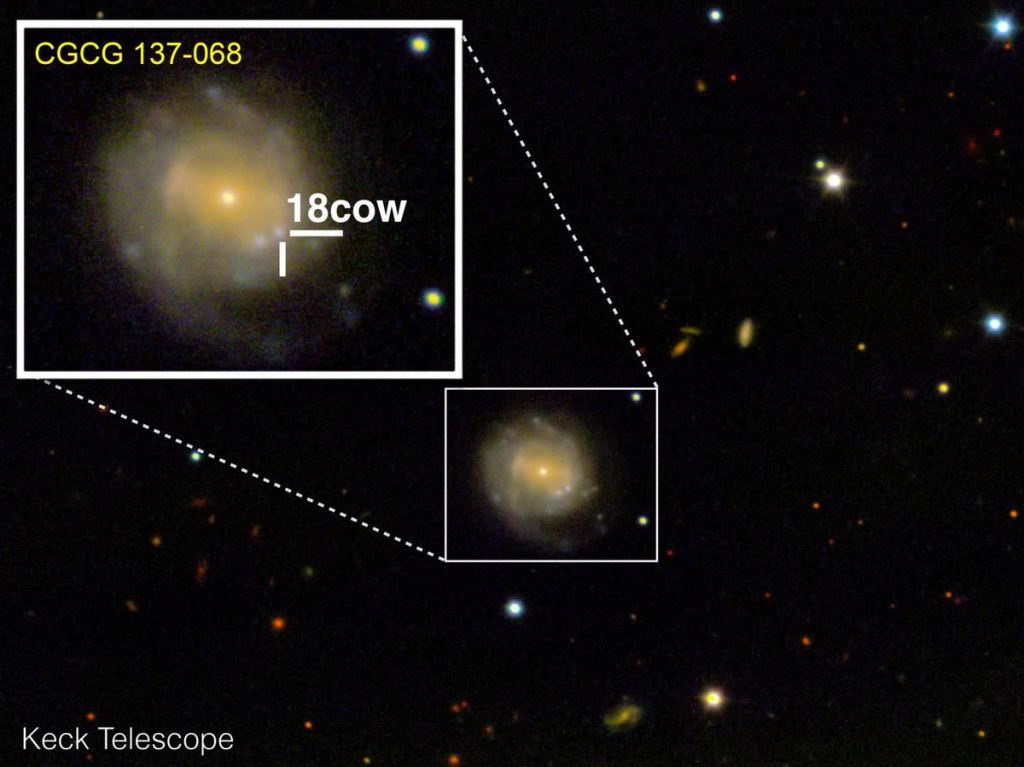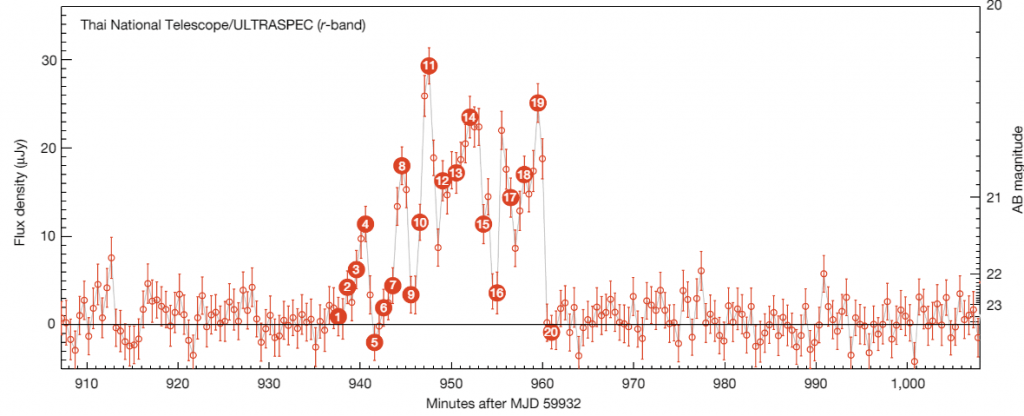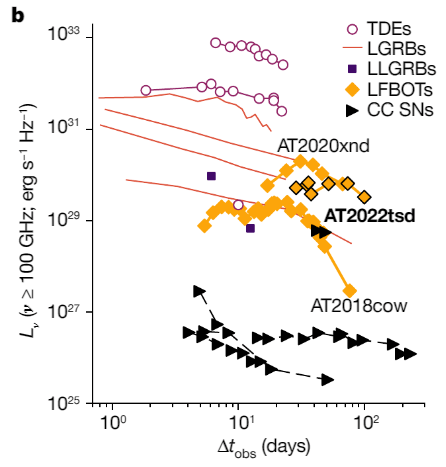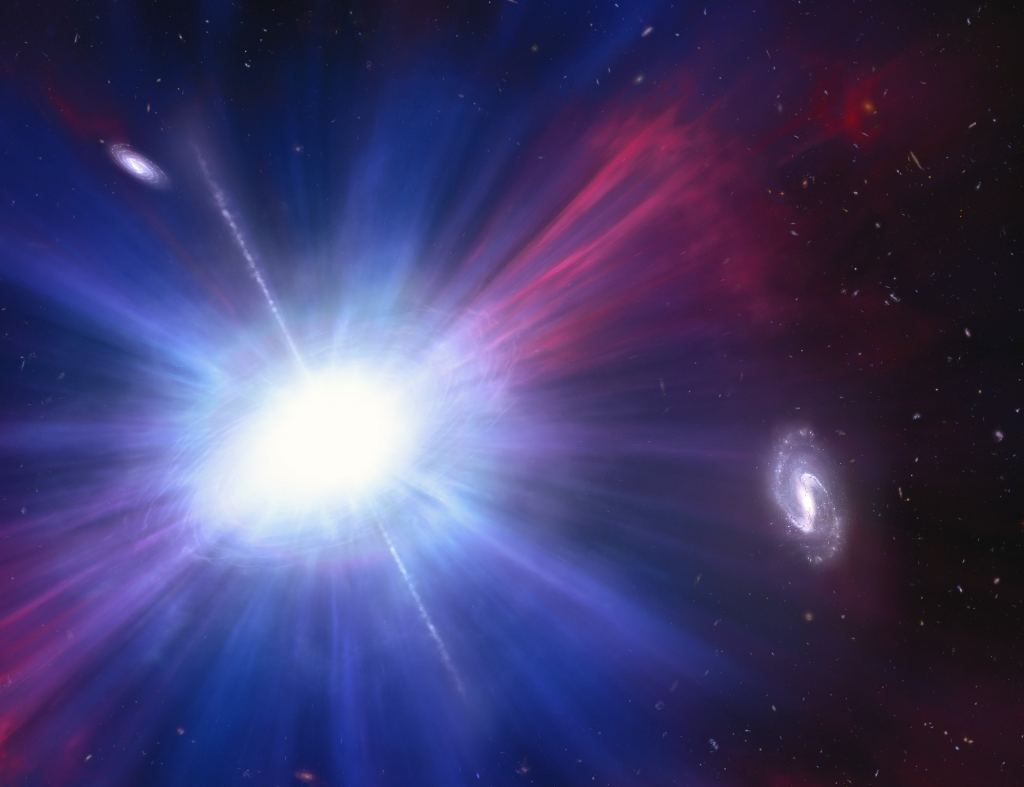In September 2022, an automated sky survey detected what seemed to be a supernova explosion about one billion light-years away. The Zwicky Transient Facility (ZTF) spotted it and gave it the name AT2022tsd. But something was different about this supernova. Supernovae explode and shine brightly for months, while AT2022tsd exploded brightly and then faded within days.
That’s when astronomers realized it wasn’t a regular supernova at all. It was a luminous fast blue optical transient (LFBOT), a relatively new class of object that was only discovered a few years earlier and remains mysterious.
Then something even stranger happened. AT2022tsd, given the nickname ‘Tasmanian Devil,’ brightened again and again. This was both a surprise and a puzzle, two things that always attract the attention of astronomers.
After its initial detection, follow-up observations in X-rays showed that the Tasmanian Devil was the brightest LFBOT ever detected. Not only that, but it rivalled the brightest gamma-ray bursts ever detected. These facts, along with the object’s repeated brightening, made it one of the strangest transients ever detected.
A team of researchers led by Cornell Assistant Professor of Astronomy Anna Ho gathered all the data they could to determine what was behind the Tasmanian Devil’s unusual behaviour. Their results are in a new paper titled “Minutes-duration optical flares with supernova luminosities.” The paper was published in the journal Nature.
“This settles years of debate about what powers this type of explosion and reveals an unusually direct method of studying the activity of stellar corpses.”
“In recent years, certain luminous extragalactic optical transients have been observed to last only a few days,” the authors write in their paper. “Their short observed duration implies a different powering mechanism from the most common luminous extragalactic transients (supernovae), whose timescale is weeks.”
“Here we report observations of minutes-duration optical flares in the aftermath of an AT2018cow-like transient, AT2022tsd.”
 AT 2018cow was a powerful explosion up to 100 times brighter than a supernova. It’s one of the few reported FBOTs. This image shows The Cow approximately 80 days after the explosion from the W.M. Keck Observatory in Maunakea, Hawaii. The Cow is nestled in the CGCG 137-068 galaxy, 200 million light years from Earth. Image Credit: Raffaella Margutti/Northwestern University
AT 2018cow was a powerful explosion up to 100 times brighter than a supernova. It’s one of the few reported FBOTs. This image shows The Cow approximately 80 days after the explosion from the W.M. Keck Observatory in Maunakea, Hawaii. The Cow is nestled in the CGCG 137-068 galaxy, 200 million light years from Earth. Image Credit: Raffaella Margutti/Northwestern UniversityThe Tasmanian Devil’s repeated flashes were as short as a few minutes long. They were also as powerful as the initial explosion 100 days prior. These repeated flashes only deepened the mystery around LFBOTs. 15 telescopes around the world watched the flashes, and the research team combed through the observations to try to determine what type of object was behind this remarkable behaviour.
In December, Ho was routinely monitoring the fading initial explosion and captured five new images of the object that each spanned a few minutes. The first image showed nothing, but the middle image showed an intense brightening that quickly vanished. Then nothing again.
Ho shared the images with collaborators, and they were speechless.
“We think these flares could be coming from one of these newly formed corpses,”
“No one really knew what to say,” Ho recalled. “We had never seen anything like that before – something so fast, and the brightness as strong as the original explosion months later – in any supernova or FBOT. We’d never seen that, period, in astronomy.”
 The Thai National Telescope captured this flare from AT2022tsd. This flare was nearly as bright as the initial burst detected with the Zwicky Transient Facility. Time on the x-axis is in minutes. Image Credit: Ho et al. 2023.
The Thai National Telescope captured this flare from AT2022tsd. This flare was nearly as bright as the initial burst detected with the Zwicky Transient Facility. Time on the x-axis is in minutes. Image Credit: Ho et al. 2023.The team’s analysis showed 14 separate spikes in brightness over a 120-day period. According to Ho, that’s likely only a fraction of the total number.
“Amazingly, instead of fading steadily as one would expect, the source briefly brightened again – and again, and again,” she said. “LFBOTs are already a kind of weird, exotic event, so this was even weirder.”
There are some events and objects out there in the cosmos that flash repeatedly, and the researchers worked to either confirm or eliminate them. The Devil wasn’t a supernova, but could it have been a tidal disruption event (TDE) where a black hole feeds on material and flares brightly? Does its light and frequency match any other type of astronomical transient?
 This figure from the research shows how the light from AT2022tsd compares to other bright transient objects. TDEs, shown in purple circles, are well outside the parameter space of the Tasmanian Devil. Other objects in the figure are Long Gamma-Ray Bursts (LGRBs) and their cousins, Long-Duration, Low-Luminosity Gamma-Ray Bursts. The figure also shows LFBOTs and CC SNs, which are Core-Collapse Supernovae. The signals from AT2022tsd don’t match those from gamma-ray bursts, tidal disruption events, or supernovae. Image Credit: Ho et al. 2023.
This figure from the research shows how the light from AT2022tsd compares to other bright transient objects. TDEs, shown in purple circles, are well outside the parameter space of the Tasmanian Devil. Other objects in the figure are Long Gamma-Ray Bursts (LGRBs) and their cousins, Long-Duration, Low-Luminosity Gamma-Ray Bursts. The figure also shows LFBOTs and CC SNs, which are Core-Collapse Supernovae. The signals from AT2022tsd don’t match those from gamma-ray bursts, tidal disruption events, or supernovae. Image Credit: Ho et al. 2023.The team detected a single optical and multiple x-ray flares from the Tasmanian Devil. But the optical flare didn’t coincide with any of the x-ray flares. Also, there was no detectable periodicity to any of the flaring. The fact that the team couldn’t find any optical flaring in the research into other LFBOTs was also confounding.
“To our knowledge, this phenomenon—minute-timescale optical flares at supernova-like luminosities, with order-of-magnitude amplitude variations, persisting for 100+ days—has no precedent in the literature,” the researchers write in their paper.
For now, AT2022tsd is still a mystery. It could be a supergiant star collapsing as a supernova and then forming an accretion ring. It could be a black hole funnelling jets of material into space. Or it could be another LFBOT, but we could be seeing it from a strange angle. If we are, that could explain the Tasmanian Devil’s X-rays.
“The lack of detected flares in other LFBOTs could be because of the viewing angle: AT2018cow is thought to have been observed close to the plane of the circumburst ‘disk’ rather than face-on, and a more on-axis viewing angle for AT2022tsd could also help explain the substantially more luminous X-ray emission,” the authors explain in their research.
 Artist’s concept of one of the brightest explosions ever seen in space: a Luminous Fast Blue Optical Transient (LFBOT). Credit: NASA
Artist’s concept of one of the brightest explosions ever seen in space: a Luminous Fast Blue Optical Transient (LFBOT). Credit: NASAThe researchers came to a conclusion, but it’s an incomplete one.
The Tasmanian Devil must be a dead star, either a black hole or a neutron star. “We don’t think anything else can make these kinds of flares,” said Anna Y.Q. Ho, assistant professor of astronomy in the College of Arts and Sciences. “This settles years of debate about what powers this type of explosion and reveals an unusually direct method of studying the activity of stellar corpses.”
If the Tasmanian Devil is a type of dead star, it’s not behaving like the others.
“We might be seeing a completely different channel for cosmic cataclysms,” Ho said.
Something unprecedented may be going on with the Devil. As a dead star, the light coming from it could signal its transition into a sort of stellar afterlife. It could be a new type of stellar corpse.
“Because the corpse is not just sitting there, it’s active and doing things that we can detect,” Ho said. “We think these flares could be coming from one of these newly formed corpses, which gives us a way to study their properties when they’ve just been formed.”

